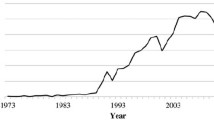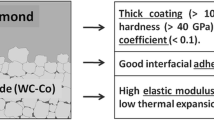Abstract
Due to its exceptional mechanical and tribological properties, nanocrystalline diamond (NCD) has the potential to be used for tool coatings that can enable dry machining of Al alloys. This study explores the friction response of NCD coatings in sliding contact with 319 Al. NCD coatings were grown using microwave plasma CVD with a range of growth conditions to explore key growth modulators governing the tribological response of this material. These coatings were then characterized with Raman spectroscopic analysis at three different wavelengths. Pin-on-disc friction response of these coatings with 319 Al showed that the trans-polyacetylene content as determined by the respective Raman spectrum in NCD is the critical factor controlling friction behavior. This finding can have significant implications in other similar applications where friction response of NCD is a key design factor.

















Similar content being viewed by others
References
Kawarada H (1996) Hydrogen-terminated diamond surfaces and interfaces. Surf Sci Rep 26:205
Qi Y, Hector LG (2003) Hydrogen effect on adhesion and adhesive transfer at aluminum/diamond interfaces. Phys Rev B 68:4
Hayward IP, Singer IL, Seitzman LE (1992) Effect of roughness on the friction of diamomd on CVD diamond coatings. Wear 157:215
Gardos MN, Soriano BL (1990) The effect of environment on the tribological properties of polycrystalline diamond films. J Mater Res 5:2599
Erdemir A, Fenske GR, Krauss AR, Gruen DM, McCauley T, Csencsits RT (1999) Tribological properties of nanocrystalline diamond films. Surf Coat Technol 121:565
Grierson DS, Sumant AV, Konicek AR, Abrecht M, Birrell J, Auciello O, Carlisle JA, Scharf TW, Dugger MT, Gilbert P, Carpick RW (2007) Tribochemistry and material transfer for the ultrananocrystalline diamond–silicon nitride interface revealed by x-ray photoelectron emission spectromicroscopy. J Vac Sci Technol B 25:1700
Konicek AR, Grierson DS, Gilbert P, Sawyer WG, Sumant AV, Carpick RW (2008) Origin of ultralow friction and wear in ultrananocrystalline diamond. Phys Rev Lett 100:235502
Gruen DM (1999) Nanocrystalline diamond films. Annu Rev Mater Sci 29:211
López-Ríos T, Sandré É, Leclercq S, Sauvain É (1996) Polyacetylene in diamond films evidenced by surface enhanced Raman scattering. Phys Rev Lett 76:4935
Harada I, Furukawa Y, Tasumi M, Shirakawa H, Ikeda S (1980) Spectroscopic studies on doped polyacetylene and beta-carotene. J Chem Phys 73:4746
Wagner J, Wild C, Koidl P (1991) Resonance effects in Raman scattering from polycrystalline diamond films. Appl Phys Lett 59:779
Marcus B, Fayette L, Mermoux M, Abello L, Lucazeau G (1994) Analysis of the structure of multi-component carbon films by resonant Raman scattering. J Appl Phys 76:3463
Birrell J, Gerbi JE, Auciello O, Gibson JM, Johnson J, Carlisle JA (2005) Interpretation of the Raman spectra of ultrananocrystalline diamond. Diam Relat Mater 14:86
Kothari AK (2009) Experiments on nanostructured carbon for wear resistant coating applications. PhD Dissertation, Brown University
Pfeiffer R, Kuzmany H, Salk N, Gunther B (2003) Evidence for trans-polyacetylene in nanocrystalline diamond films from H-D isotropic substitution experiments. Appl Phys Lett 82:4149
Pfeiffer R, Kuzmany H, Knoll P, Bokova S, Salk N, Gunther B (2003) Evidence for trans-polyacetylene in nano-crystalline diamond films. Diam Relat Mater 12:268
Fredriksson C, Bredas JL (1993) Metal/conjugated polymer interfaces: a theoretical investigation of the interaction between aluminum and trans-polyacetylene oligomers. J Chem Phys 98:4253
Fredriksson C, Lazzaroni R, Bredas JL, Ouhlal A, Selmani A (1994) Metal/conjugated polymer interfaces: a local density functional study of aluminum/polyene interactions. J Chem Phys 100:9258
Hurtado J, Kim K (1999) Scale effects in friction of single-asperity contacts. II. Multiple-dislocation-cooperated slip. Proc R Soc Lond A 455:3385–3400
Acknowledgements
The authors gratefully acknowledge the financial support of the Brown-GM CRL. BWS also acknowledges support by the US Department of Energy, Office of Basic Energy Sciences under Contract DE-FG02-10ER46771.
Author information
Authors and Affiliations
Corresponding author
Rights and permissions
About this article
Cite this article
Kothari, A.K., Xiao, X., Sheldon, B.W. et al. The impact of nanocrystalline diamond grain boundary chemistry on frictional response in sliding contact with 319Al alloy. J Mater Sci 50, 2993–3003 (2015). https://doi.org/10.1007/s10853-015-8864-9
Received:
Accepted:
Published:
Issue Date:
DOI: https://doi.org/10.1007/s10853-015-8864-9




